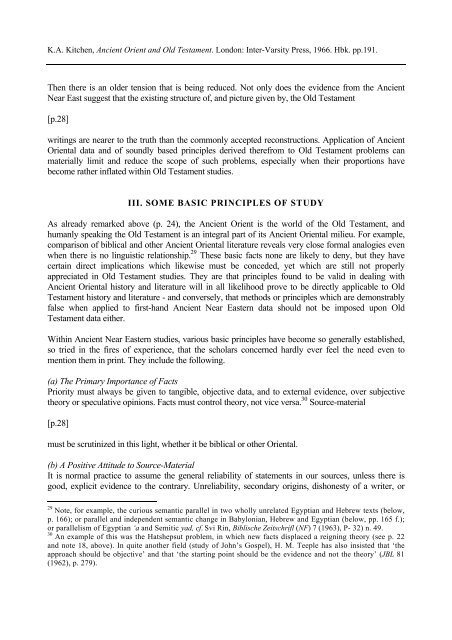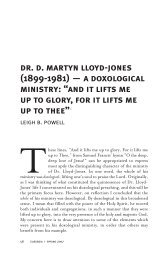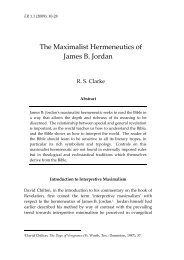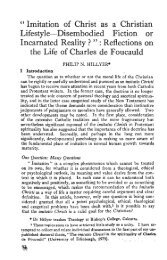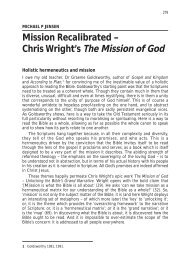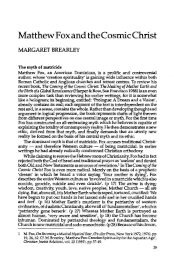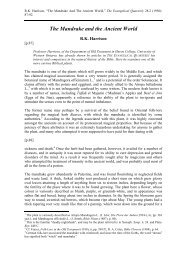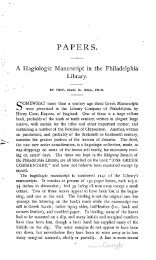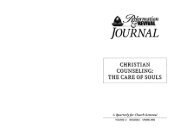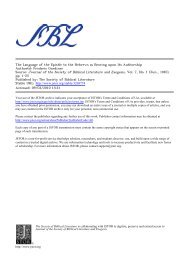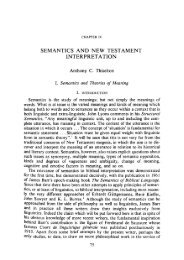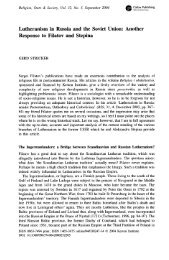Ancient Orient and Old Testament - BiblicalStudies.org.uk
Ancient Orient and Old Testament - BiblicalStudies.org.uk
Ancient Orient and Old Testament - BiblicalStudies.org.uk
You also want an ePaper? Increase the reach of your titles
YUMPU automatically turns print PDFs into web optimized ePapers that Google loves.
K.A. Kitchen, <strong>Ancient</strong> <strong>Orient</strong> <strong>and</strong> <strong>Old</strong> <strong>Testament</strong>. London: Inter-Varsity Press, 1966. Hbk. pp.191.<br />
Then there is an older tension that is being reduced. Not only does the evidence from the <strong>Ancient</strong><br />
Near East suggest that the existing structure of, <strong>and</strong> picture given by, the <strong>Old</strong> <strong>Testament</strong><br />
[p.28]<br />
writings are nearer to the truth than the commonly accepted reconstructions. Application of <strong>Ancient</strong><br />
<strong>Orient</strong>al data <strong>and</strong> of soundly based principles derived therefrom to <strong>Old</strong> <strong>Testament</strong> problems can<br />
materially limit <strong>and</strong> reduce the scope of such problems, especially when their proportions have<br />
become rather inflated within <strong>Old</strong> <strong>Testament</strong> studies.<br />
III. SOME BASIC PRINCIPLES OF STUDY<br />
As already remarked above (p. 24), the <strong>Ancient</strong> <strong>Orient</strong> is the world of the <strong>Old</strong> <strong>Testament</strong>, <strong>and</strong><br />
humanly speaking the <strong>Old</strong> <strong>Testament</strong> is an integral part of its <strong>Ancient</strong> <strong>Orient</strong>al milieu. For example,<br />
comparison of biblical <strong>and</strong> other <strong>Ancient</strong> <strong>Orient</strong>al literature reveals very close formal analogies even<br />
when there is no linguistic relationship. 29 These basic facts none are likely to deny, but they have<br />
certain direct implications which likewise must be conceded, yet which are still not properly<br />
appreciated in <strong>Old</strong> <strong>Testament</strong> studies. They are that principles found to be valid in dealing with<br />
<strong>Ancient</strong> <strong>Orient</strong>al history <strong>and</strong> literature will in all likelihood prove to be directly applicable to <strong>Old</strong><br />
<strong>Testament</strong> history <strong>and</strong> literature - <strong>and</strong> conversely, that methods or principles which are demonstrably<br />
false when applied to first-h<strong>and</strong> <strong>Ancient</strong> Near Eastern data should not be imposed upon <strong>Old</strong><br />
<strong>Testament</strong> data either.<br />
Within <strong>Ancient</strong> Near Eastern studies, various basic principles have become so generally established,<br />
so tried in the fires of experience, that the scholars concerned hardly ever feel the need even to<br />
mention them in print. They include the following.<br />
(a) The Primary Importance of Facts<br />
Priority must always be given to tangible, objective data, <strong>and</strong> to external evidence, over subjective<br />
theory or speculative opinions. Facts must control theory, not vice versa. 30 Source-material<br />
[p.28]<br />
must be scrutinized in this light, whether it be biblical or other <strong>Orient</strong>al.<br />
(b) A Positive Attitude to Source-Material<br />
It is normal practice to assume the general reliability of statements in our sources, unless there is<br />
good, explicit evidence to the contrary. Unreliability, secondary origins, dishonesty of a writer, or<br />
29 Note, for example, the curious semantic parallel in two wholly unrelated Egyptian <strong>and</strong> Hebrew texts (below,<br />
p. 166); or parallel <strong>and</strong> independent semantic change in Babylonian, Hebrew <strong>and</strong> Egyptian (below, pp. 165 f.);<br />
or parallelism of Egyptian ‘a <strong>and</strong> Semitic yad, cf. Svi Rin, Biblische Zeitschrifl (NF) 7 (1963), P- 32) n. 49.<br />
30 An example of this was the Hatshepsut problem, in which new facts displaced a reigning theory (see p. 22<br />
<strong>and</strong> note 18, above). In quite another field (study of John’s Gospel), H. M. Teeple has also insisted that ‘the<br />
approach should be objective’ <strong>and</strong> that ‘the starting point should be the evidence <strong>and</strong> not the theory’ (JBL 81<br />
(1962), p. 279).


